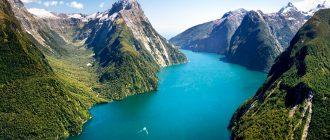Ljubljana (Slovenia) – the most detailed information about the city with photos. The main attractions of Ljubljana with a description, guides and cards.
Contents
City Ljubljana (Slovenia)
Ljubljana is the capital and largest city of Slovenia, located on the banks of the river Ljubljanica in a picturesque valley. This is the main cultural transport and economic center of the country in which it lives almost 300 thousand people. Ljubljana is one of the smallest and most cozy. European capitals. Here you will not find the world famous attractions, but there are interesting historical monuments and architecture: the old castle (Grad), antique and medieval constructions, baroque ensembles of 17-18 centuries.
- Story
- Climate and weather
- Best time to visit
- How to get there
- Shopping
- Gastronomy
- sights
- Tourist Card
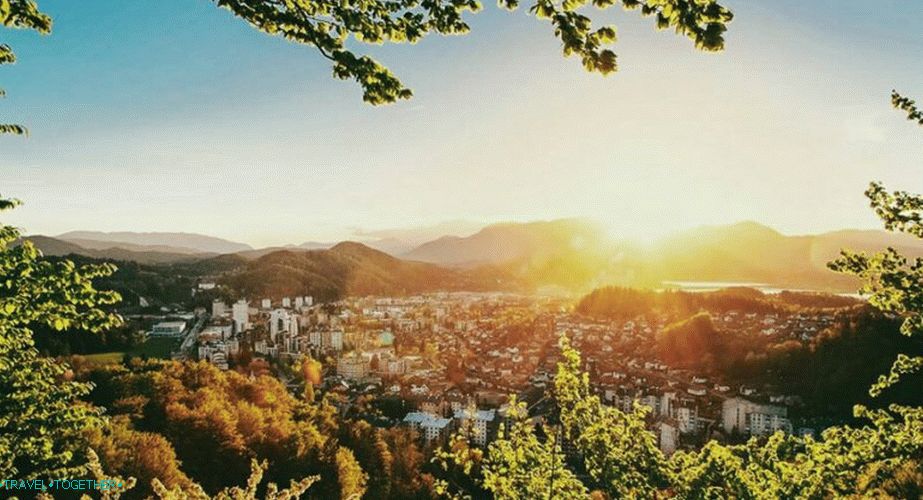 Panorama of Ljubljana
Panorama of Ljubljana
Ljubljana is a charming green city, one of the most comfortable and comfortable for living in Europe. In the center of the capital of Slovenia by Baroque buildings and under the ramparts of the ancient castle flows the river Ljubljanica with emerald water. The historical core of the city is located on the east side of the river, the new city – on the west. The river is crossed by many picturesque small bridges.
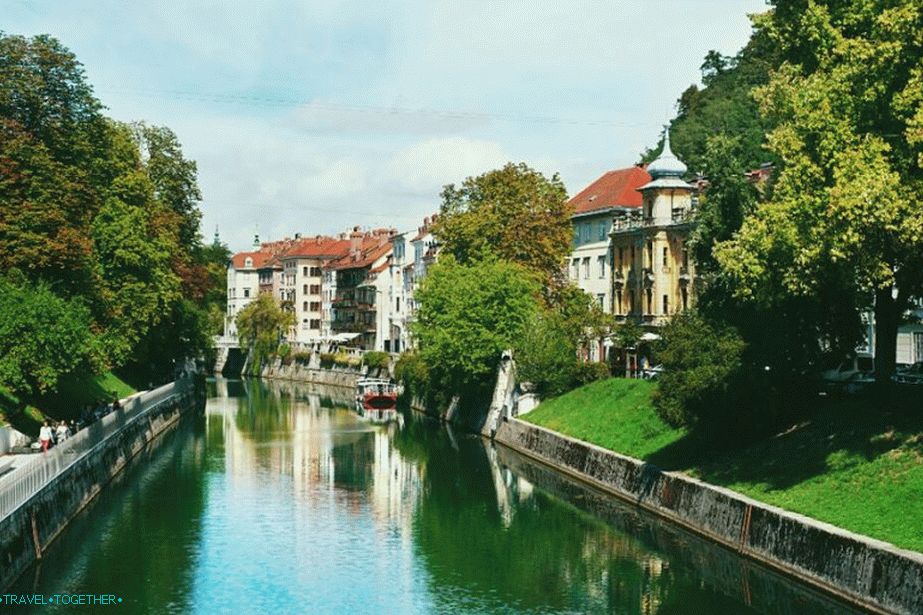 Ljubljanica river
Ljubljanica river
Story
The first settlements on the territory of modern Ljubljana existed about 4,000 years ago. In the 10th century, the city was settled venety, later came the Celts.
In antiquity there was founded a Roman settlement – Emona. Due to its good location at the crossroads connecting The Danube and the Adriatic, the settlement quickly grew and developed. Roman the city was located at the foot of the castle hill on the right bank of the river Ljubljanica. The settlement was surrounded by a six-meter wall with 29 towers. The Romans also brought all the benefits of antiquity to Ljubljana. civilizations: stone houses, public baths, plumbing and sewer. In the 4-6th century after the collapse of the Roman Empire, the city came in decline. He was captured by the barbarians, the Lombards. It got to the point that the city was practically depopulated, and about once large enough the settlement resembled only ruins.
At the beginning of the Middle Ages, the territory of Ljubljana was first under power avars, and later – francs.
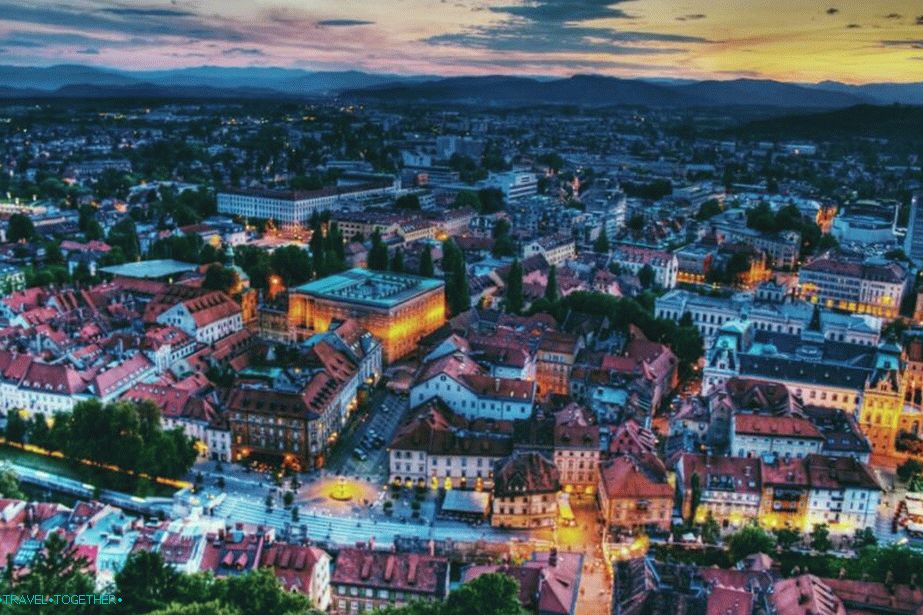 Panorama Ljubljana
Panorama Ljubljana
The first written references to Ljubljana relate to the beginning of 12 century. Around this time, an ancient castle was built on the hill – Hail. Medieval Ljubljana developed under the castle on the east bank of the river Ljubljanica. In the second half of the 13th century, the city passed under the power of Bohemia, and at the beginning of the 14th century – the Habsburgs. At that time Ljubljana has received the name on German manners – Laybah.
In the early 16th century, after the earthquake, the city began to rebuild in the Renaissance style, a new fortress wall was erected.
In the late 19th century, another major earthquake severely damaged Ljubljana After him, the city received a new, modern look.
Climate and weather
The climate of Ljubljana is moderately continental, with warm summers and mild winter. The weather in summer is usually very warm, the average temperature about 20 degrees. In winter, temperatures around 0 are possible. small frosts and snowfalls. Great weather prevails in late spring. and early autumn. At this time, warm and dry.
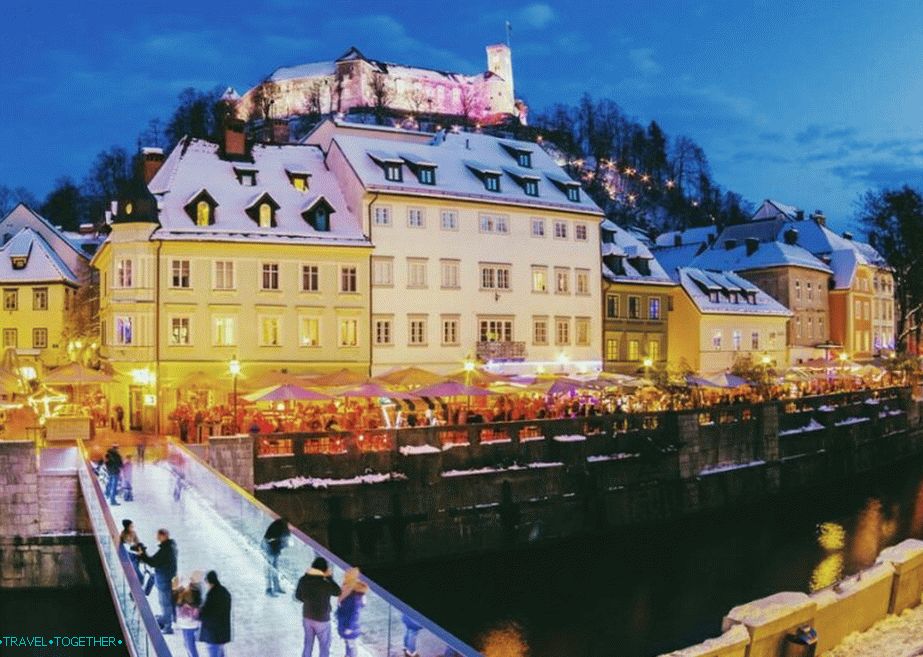 Ljubljana in winter
Ljubljana in winter
Best time to visit
Ljubljana can be visited year-round. But the best time Visits are considered April-May and September-October.
How to get there
By plane
At 27 km from Ljubljana there is an international airport, which accepts flights from Moscow, Paris, Munich, Frankfurt, Prague, Warsaw, Istanbul and other major European cities. From the airport to Ljubljana can be reached by bus (ticket price 4.1 euros) or taxi for 30-40 euros.
By train
Ljubljana is the largest railway hub of Slovenia. Iron roads connect it not only with the cities of the country, but also Zagreb, Budapest, Pula, Vienna, Salzburg.
By bus
By bus you can get to Ljubljana from Trieste, Bologna, Florence, Belgrade, Munich and other cities. Schedule and tickets for bus see here -http: //www.ap-ljubljana.si/en/
 Panorama Ljubljana
Panorama Ljubljana
Shopping and shopping
Shopping is not what they go to Ljubljana for. Although there is options to make a purchase. Ljubljana’s largest shopping center – BTCCity Shopping District, located in the northeast parts of the city. You can reach it by bus 27. Many shops focused on the street Čopova in the Old Town. By Sunday on the street Gallusovo nabrezje running flea market. The central market of Ljubljana is located on SquareVodnikov.
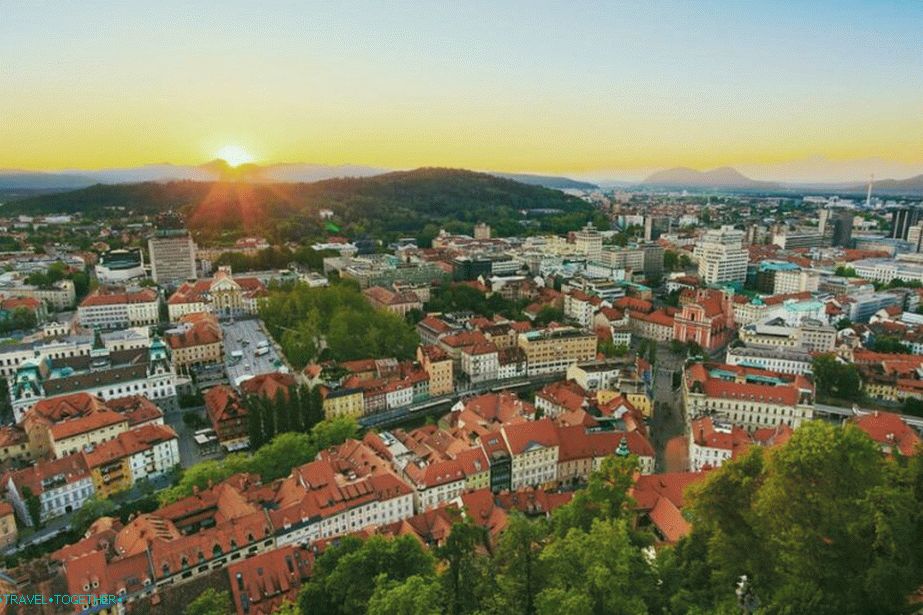 Panorama Ljubljana
Panorama Ljubljana
Gastronomy
The old center of Ljubljana is filled with cozy restaurants and cafes. Here you can taste Slovenian, Italian and Austrian cuisine.
Here you can find Austrian schnitzel and strudel in the menu, Italian pasta, risotto and pizza, Hungarian goulash. From local dishes stand out like our dumplings štruklji with different dried pork (prushut), potato dumplings, soup from beans, a type of Italian polenta, garlic ribs, Traditional Slovene Pie Pie.
Budget and cheap places:
- Falafel, Trubarjeva 40
- Nobel Burek, Miklošičeva 30
- Cafe Romeo, Stari trg 6
- Casa del Papa, Celovska 54a
- Emonska Klet, Plecnikov Trg 1
- Gostilna Pod Rožnikom, Cesta na Roznik 18
- Ljubljanski Dvor, Dvorni trg 1
- Vodnikov hram, Vodnikov trg 2
- Stara Mačka, Krojaška ulica 8
 Ljubljana – view on the city
Ljubljana – view on the city
Sights of Ljubljana
The main attractions of Ljubljana are concentrated in the Old the city. The historic core of the city is located between the castle hill and the river. The old town is an ancient medieval streets and squares, historical buildings and structures from different periods, Baroque ensembles.
Within walking distance to the west of the historic The remains of the Roman fortress walls, including a number of pillars with entrance gates.
 Triple Bridge
Triple Bridge
Triple Bridge – an architectural ensemble of three pedestrian bridges, built on the site of a medieval wooden bridge on the project Jozha Plecnik in 1842. This is one of the symbols of Ljubljana.
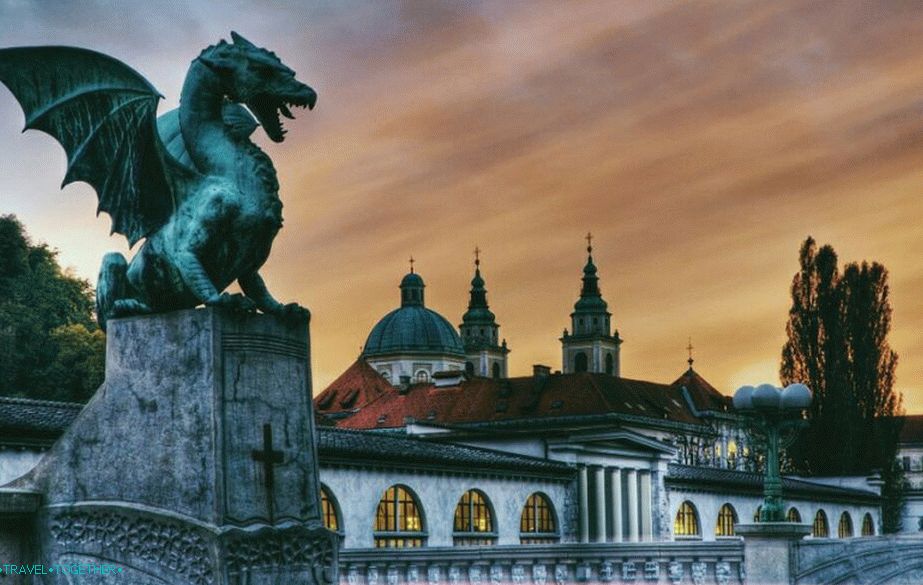 Zmaisky bridge
Zmaisky bridge
Zmajski Bridge or Dragon Bridge – one of the symbols of Ljubljana, the bridge built in 1901. This Art Nouveau masterpiece is guarded by four dragon sculptures.
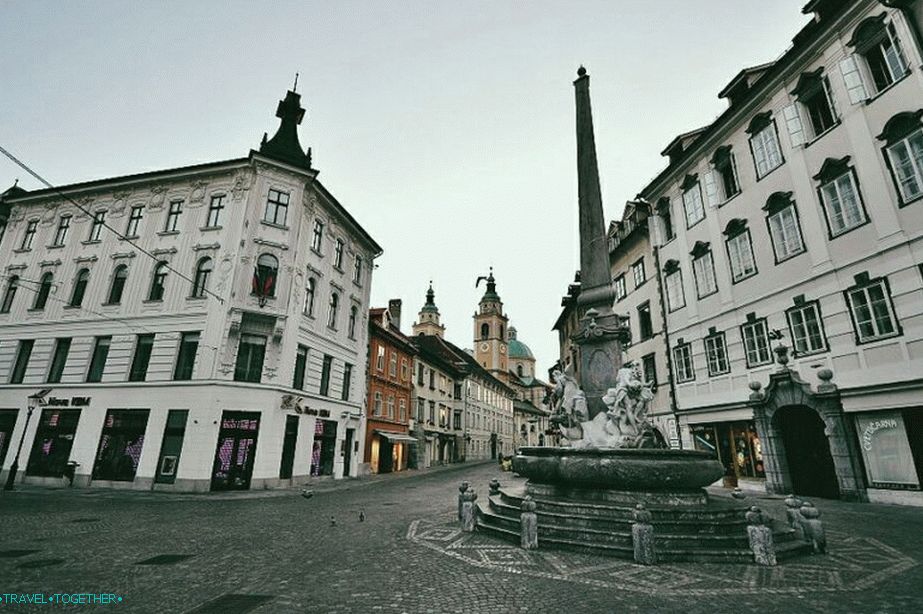 Robb fountain
Robb fountain
The Robb Fountain or the Fountain of the Three Rivers is an outstanding monument Slovenian baroque built between 1743 and 1751 over the years the Venetian sculpture of Francesco Robb. It is based on images of the famous fountains of Rome.
Next to the fountain is located the town hall building, built in 15 century. The town hall was rebuilt in the 18th century. The facade of the building is made in Venetian style with gothic elements.
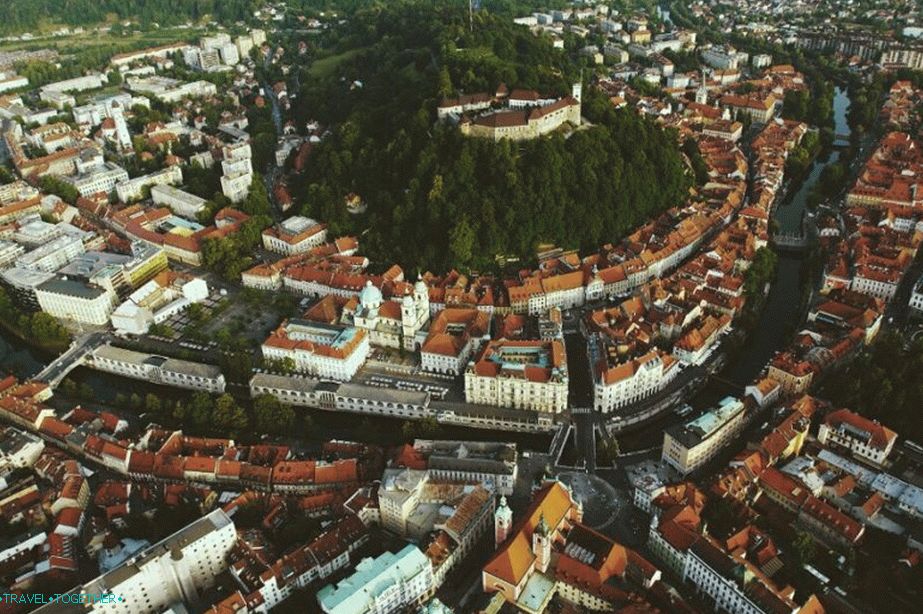 Ljubljana Castle
Ljubljana Castle
Ljubljana Castle – the landmark landmark of the city. An ancient castle, whose history dates back 900 years. This old The medieval fortress is located on a high hill, on which You can climb the funicular. The best views from here Ljubljana Entrance to the courtyard of the castle is free. Paid only funicular and entrance to the observation tower.
The mode of operation of the castle and funicular:
- January-March, November: 10: 00-20: 00 daily
- April, May, October: 9: 00-21: 00, daily
- From June to September: 9: 00-23: 00 daily
- December: 10: 00-22: 00 daily.
 Tivoli Park
Tivoli Park
Tivoli Park – a huge green area almost in the center of the city. it The main city park of Ljubljana, one of the favorite places for walking among residents and visitors of the city.
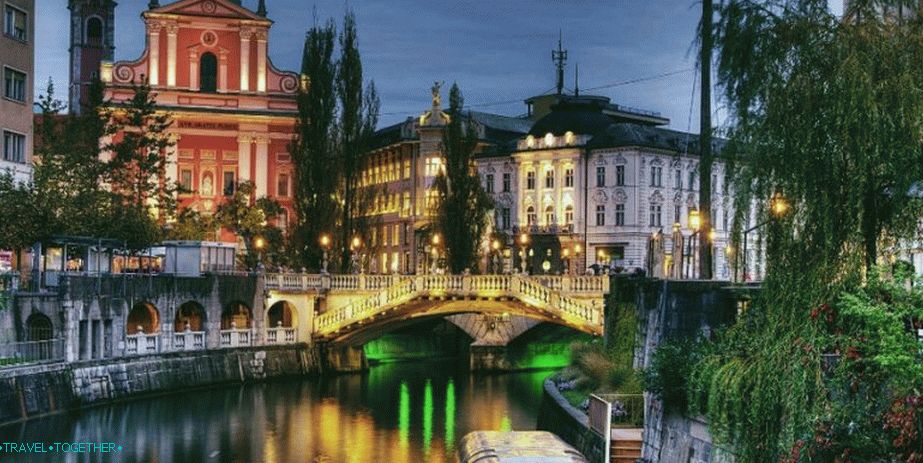 Franciscan monastery
Franciscan monastery
Franciscan Monastery and Church of the Annunciation – Old monastery of the 17th century, the former abode of the Augustinians until the end of the 18th century. Rebuilt in baroque style in the 19th century. The church has a monumental the altar, designed by Robb and beautiful frescoes.
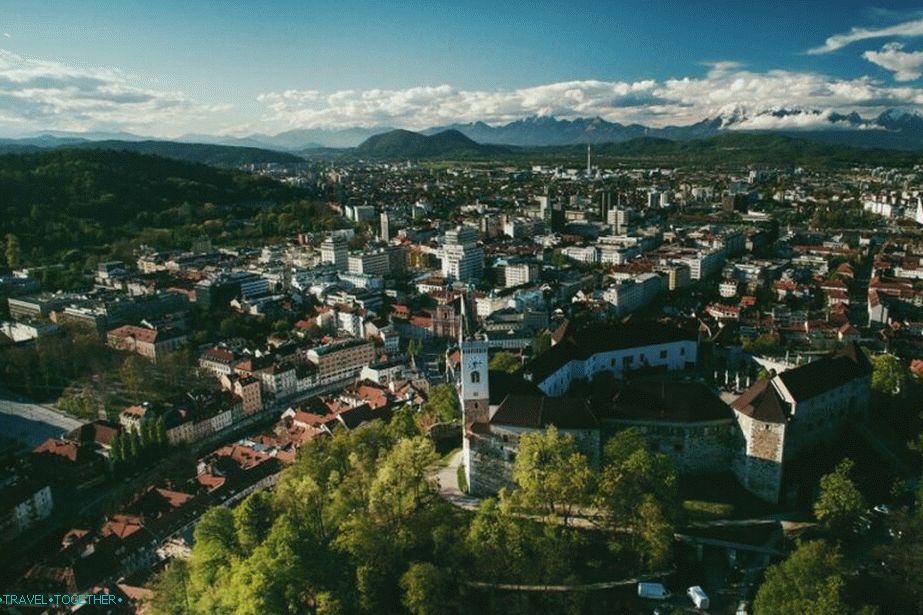 View of Ljubljana castle
View of Ljubljana castle
Cathedral of sv. Nicholas – one of the oldest temples city, built in the Baroque style in the early 18th century. Has the form Latin cross. The first Romanesque church was built on this. place in the 13th century.
On the outskirts of the historic center of Ljubljana is the parish church of sv. Petra. This is one of the most prominent examples of Slovenian Baroque, built in the first half of the 18th century by the architect Giovanni Fasconi. In the 13th century, a Romanesque site was located on this site. Church, burnt by the Turks in the 15th century.
Tourist Card
Detailed tourist map of Ljubljana with marked sights.
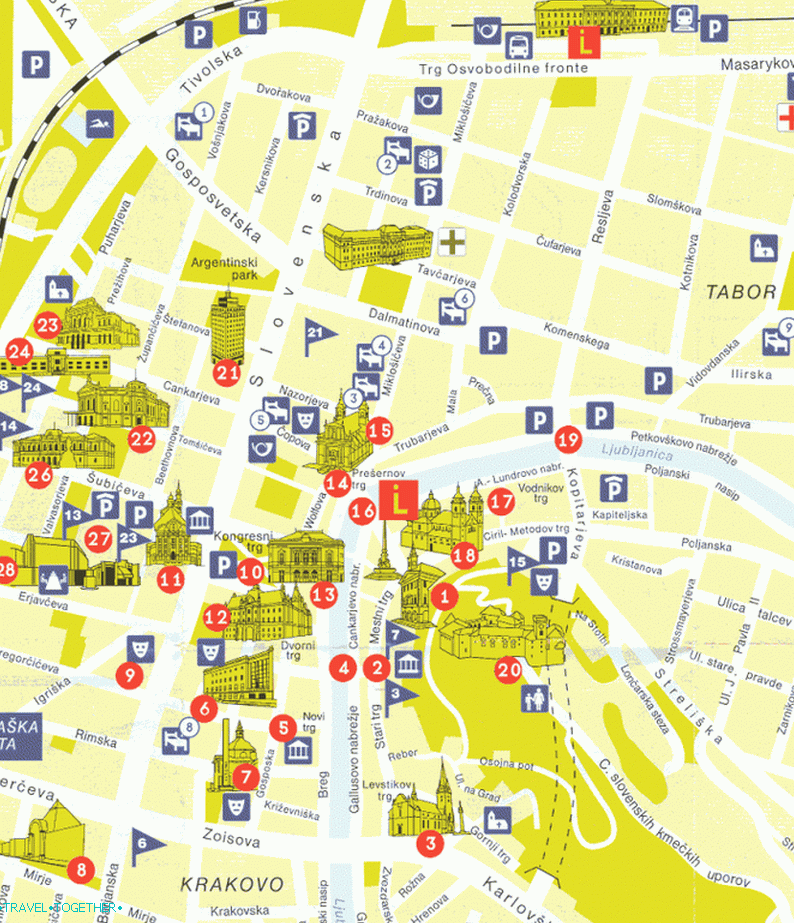 Tourist Ljubljana map
Tourist Ljubljana map
Video
Maps and guides
Travel guide to Ljubljana with a map (eng)





